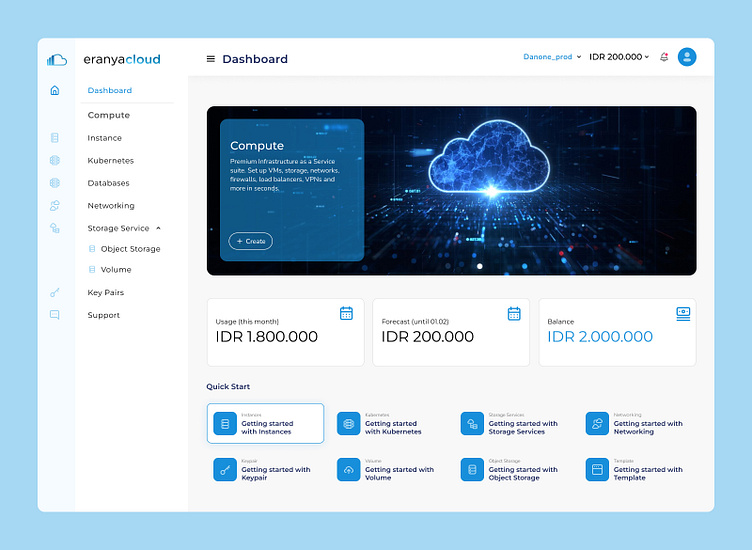Cloud Console By Eranyacloud
This is the first time I've worked on a product design project for cloud computing. Designing the UX/UI for a console on a cloud platform involves creating an interface that allows users to efficiently manage and interact with various cloud services and resources.
The method to create a UI/UX design for this cloud console product is something like this:
User Research:
Understand the needs, goals, and pain points of users who will be using the cloud platform console, such as developers, administrators, and IT professionals.
Identify common tasks and workflows performed by users, such as provisioning resources, monitoring performance, and managing security settings.
Define Goals:
Establish clear objectives for the console, such as improving productivity, enhancing usability, and providing seamless access to cloud services.
Prioritize features based on their importance to users and alignment with business goals.
Information Architecture:
Organize the console's layout and structure logically, grouping related features and functions together.
Define navigation paths that allow users to access different sections of the console easily and intuitively.
Wireframing and prototyping:
Create low-fidelity wireframes to outline the basic layout and functionality of the console.
Develop interactive prototypes to visualize user interactions and validate design concepts with stakeholders.
UI Design:
Design a clean and intuitive interface that reflects the brand identity and provides a seamless user experience.
Use visual hierarchy, typography, and color to guide users' attention and highlight important information.
Ensure consistency in design elements and patterns across the console to enhance usability and familiarity.
Console Components:
Dashboard:
Provide a centralized view of key metrics, alerts, and notifications to give users insights into the overall health and status of their cloud resources.
Resource Management:
Offer tools for users to provision, configure, and manage cloud resources, such as virtual machines, storage, and databases.
Monitoring and Analytics:
Enable users to monitor performance metrics, track usage trends, and analyze data to optimize resource allocation and identify potential issues.
Security and Compliance:
Include features for managing access controls, encryption settings, and compliance policies to ensure the security and integrity of cloud resources.
Automation and Integration:
Integrate with automation tools and APIs to enable users to automate repetitive tasks, orchestrate workflows, and integrate with third-party services.
Settings and Preferences:
Allow users to customize their settings, manage their account information, and configure preferences to personalize their console experience.
Feedback and iteration:
Gather feedback from users through usability testing, surveys, and feedback channels.
Iterate on the design based on user feedback, addressing any usability issues or areas for improvement.
Integration and Development:
Collaborate with developers to ensure that the design is implemented accurately and meets technical requirements.
Provide developers with design assets, specifications, and guidelines to facilitate implementation.
Testing and Optimization:
Conduct thorough testing to identify and fix any bugs, inconsistencies, or performance issues.
Monitor user engagement and behavior to identify areas for optimization and enhancement post-launch.
Launch and Post-Launch Support:
Release the console to users and provide support and documentation to help them navigate and use the platform effectively.
Continuously monitor user feedback and analytics to make iterative improvements and ensure the console meets the evolving needs of users.
By following this process and focusing on user-centered design concepts, we can construct a cloud platform dashboard that allows users to efficiently and effectively manage their cloud resources.
Please visit the eranyacloud.com site to see actual results.











